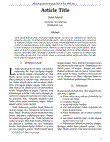Search Results - Cannes~
Suggested Topics within your search.
Suggested Topics within your search.
- 15
- México 11
- Mexico 8
- Monterrey 7
- innovación 7
- Historia 6
- Nuevo León 6
- cáncer 6
- COVID-19 5
- Educación Superior 5
- educación superior 5
- estudiantes 5
- televisión 5
- América Latina 4
- Artículo 4
- I21 4
- Innovación 4
- Latin America 4
- Violence 4
- analysis 4
- antioxidantes 4
- capital humano 4
- competencias 4
- derechos humanos 4
- educación 4
- education 4
- emprendimiento 4
- higher education 4
- human rights 4
- identidad 4
-
2901
Prevalencia de diabetes tipo 2 e hipertensión arterial en adultos de nivel económico bajo de Monterrey, México
Published 2007“…Age, body mass index and gender prognosticated in an independent manner the values of hypertension (p < 0.001). Glycemia was prognosticated based on age (p < 0.01) and body mass index (p < 0.05). …”
Get full text
Article -
2902
Evaluación geomecánica y cinemática del tramo Juan Capitán–El Chihue, Ciudad Victoria, Tamaulipas (carretera TAM-126 rumbo nuevo).
Published 2018“…ABSTRACT Assess the geomechanical and kinematic conditions of a site under construction, imply that we are venturing into determining the viability of civil works, in the sense of qualifying and suggesting the strategy for the work be carried out in a safe manner, that meets its objective for which it was planned and satisfies the guidelines of available time and financial resources. …”
Get full text
Tesis -
2903
Asociación de niveles de Vitamina D sérica y riesgo de malnutrición según grado de fragilidad en adultos mayores
Published 2023“…Se ha vinculado un nivel bajo de vitamina D con un mayor riesgo de diabetes mellitus tipo 1 y tipo 2, enfermedades cardiovasculares, ciertos cánceres, deterioro cognitivo, depresión, autoinmunidad, alergia, malnutrición e incluso fragilidad. …”
Get full text
Tesis -
2904
Biomass and lipid induction strategies in microalgae for biofuel production and other applications
Published 2019“…There are different types of biofuels (categories and generations) that have been previously explored, but recently, the use of microalgae has been strongly considered for the production of biofuels since they present a series of advantages over other biofuel production sources: (a) they don’t need arable land to grow and therefore do not compete with food crops (like biofuels produced from corn, sugar cane and other plants) and; (b) they exhibit rapid biomass production containing high oil contents, at least 15 to 20 times higher than land based oleaginous crops. …”
Get full text
Article -
2905
Global Trends in Aquaculture and Feed Ingredient Use in Compound Aquafeeds
Published 2013“…By region, Asia accounted for over 91.2 percent of total global aquaculture production in 2011 (APR 8.46 percent since 1984), followed by the Americas at 3.53 percent (APR 7.59 percent), Europe at 3.20 percent (APR 3.99 percent), Africa at 1.84 percent (APR 14.82 percent), and Oceania at 0.25 percent (APR 9.02 percent).In terms of the major farmed species groups in 2011, finfish accounted for 41.6 million tonnes or 49.8 percent of total global aquaculture production in 2011 (valued at US $ 83.6 billion, with over 102 reported fish species, and production growing at an average APR of 8.85 percent since 1984), followed by aquatic plants at 21.0 million tonnes or 25.1% of total global production (valued at US $ 5.5 billion, with 12 reported aquatic plant species, and production growing at an average APR of 7.16 percent since 1984), molluscs at 14.4 million tonnes or 17.2 percent of total global production (valued at US $ 15.3 billion, with 27 reported mollusk species, and production growing at an average APR of 7.17 percent since 1984), and crustaceans at 5.9 million tonnes or 7.0 percent of total global production (valued at US $ 28.4 billion, with 15 reported crustacean species, and production growing at an average APR 13.1 percent since 1984; FAO, 2013).The total production of the major finfish and crustacean species groups fed industrially compounded or farm-made aquafeeds was reported to be 40.57 million tonnes in 2011 (FAO, 2013), with total global industrial compound aquafeed production estimated at approximately 35.75 million tonnes; the major compound feed fed species groups including: Chinese carp at 11.76 million tonnes (excluding silver carp and big head carp) with an estimated total compound aquafeed requirement of 10.19 million tonnes; Tilapia at 3.96 million tonnes with an estimated total compound aquafeed requirement of 5.79 million tonnes or 16.2 percent of total global compound aquafeed production;Shrimp at 3.93 million tonnes with an estimated total compound feed requirement of 5.54 million tonnes or 15.5 percent of total global compound aquafeed production; Catfish at 3.38 million tonnes with an estimated total compound feed requirement of 3.70 million tonnes or 10.3 percent of total global compound aquafeed production; Marine fish at 2.01 million tonnes with an estimated total compound feed requirement of 2.82 million tonnes or 7.9 percent of total global compound aquafeed production; Other freshwater and diadromous fish at 1.94 million tonnes with an estimated total compound feed requirement of 1.24 million tonnes or 3.5 percent of total global compound aquafeed production; Salmon at 1.93 million tonnes with an estimated total compound feed requirement of 2.51 million tonnes or 7.0 percent of total global compound aquafeed production; Freshwater crustaceans at 1.67 million tonnes with an estimated total compound feed requirement of 1.71 million tonnes or 4.8 percent of total global compound aquafeed production; Milkfish at 891,407 tonnes with an estimated total compound feed requirement of 820,000 tonnes or 2.3 percent of total global compound aquafeed production; Trout at 791,959 tonnes with an estimated total compound feed requirement of 1.03 million tonnes or 2.9 percent of total global compound aquafeed production; Eel at 255,284 tonnes with an estimated total compound feed requirement of 392,000 tonnes or 1.1 percent of total global compound aquafeed production in 2011.In terms of feed ingredient usage, the compound aquafeed sector still remains the largest consumer of fishmeal and fish oil, aquaculture consuming 78 percent of total global fish oil production in 2011 (major aquaculture species group consumer being salmonids at 66 percent followed by marine fish at 17 percent) and 68% of total global fishmeal production in 2011 (major aquaculture species group consumer being crustaceans at 30 percent, followed by salmonids at 22 percent, and marine fish at 21 percent; Dr Andrew Jackson, personal communication, The Marine Ingredients Organization, http://iffo.net). …”
Get full text
Article -
2906
-
2907
Estudio de desgasificación en materiales plásticos para un portalámparas de iluminación automotriz.
Published 2019“…La empresa CEMM MEX S.A. de C.V, se especializa en la fabricación de productos de interconexión e iluminación exterior para la industria automotriz, como son arneses, portalámparas y conectores automotrices fabricados principalmente con materiales plásticos. …”
Get full text
Tesis -
2908
-
2909
Estudio de desgasificación en materiales plásticos para un portalámparas de iluminación automotriz.
Published 2019“…La empresa CEMM MEX S.A. de C.V, se especializa en la fabricación de productos de interconexión e iluminación exterior para la industria automotriz, como son arneses, portalámparas y conectores automotrices fabricados principalmente con materiales plásticos. …”
Get full text
Tesis -
2910
Resolución de conflictos, política educativa, estado de derecho, y geopolítica: Pasado y presente
Published 2020“…El lector también puede consultar la investigación interinstitucional de José María Ramos García (El Colegio de la Frontera Norte, México), Carlos Barrachina Lisón (Universidad Anáhuac, México) y Jimmy Emmanuel Ramos (Universidad Autónoma de Baja California), quienes ponderan sobre los retos de la frontera sur de México, en cuanto a su importancia en su relación con Estados Unidos.Por último, la edición cuenta con contribuciones internacionales notables sobre temas actuales y también, de una introspección de la evolución de un partido político que ha sido fundamental para la democracia española: En ellos se encuentra reflejado el compromiso de la revista Política, Globalidad y Ciudadanía de difundir proyectos de investigación de temas vigentes, así como aquellos que contienen una oportuna revisión histórica.En lo relacionado al tema se encuentra con una vigencia oportuna, el trabajo de Juan Sebastián Sánchez Gómez (Universidad de los Andes, Colombia) quien expone el caso del estado de excepción decretado en Colombia a partir de la pandemia de coronavirus. …”
Get full text
Article


